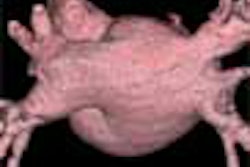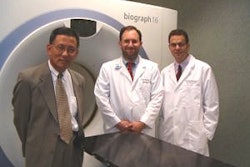There is no significant difference in the accuracy of low-dose versus normal-dose CT for diagnosing acute appendicitis, according to researchers from Erasmus Hospital in Brussels, Belgium.
Diagnostic accuracy as high as 98%, as well as the reproducibility of exams and rising image quality resulting from the use of MDCT scanners, have made CT an increasingly popular choice for the evaluation of right-upper-quadrant pain often associated with acute appendicitis, the authors wrote in this month's Radiology.
"CT, however, also delivers ionizing radiation to patients," they wrote. "Since many individuals suspected of having acute appendicitis are young, with a mean age of 30 years, radiation dose is of particular concern," (Radiology, July 2004, Vol. 232:1, pp. 164-172).
The study examined 95 consecutive patients (57 women, mean age 38; 37 men, mean age 37) who were admitted to the emergency room for the evaluation of right-upper-quadrant pain. They agreed to undergo CT imaging of the upper abdomen twice, first with a normal-dose protocol, then with low-dose MDCT. The exclusion criteria included pregnancy, prior appendectomy, or age less than 15 years.
All of the CT data were acquired on a four-detector Somatom Plus 4 Volume Zoom scanner (Siemens Medical Solutions, Malvern, PA), without contrast. Following a scout view obtained at 120 kVp and 50 mAs, two scans were acquired from the top of the liver to the symphysis pubis using 4 x 2.5-mm collimation, pitch 1.5:1.0, 120 kVp.
The radiation dose was varied by adjusting mAs: 100 and 30 effective mAs were used for the standard and low-dose exams, respectively. Transverse sections 3 mm thick were reconstructed at 1.5-mm increments for review. And in the event the results of the unenhanced exams were equivocal, the attending radiologist was authorized to scan the patients again using contrast enhancement (Ultravist 370, Schering, Berlin, Germany).
For the study, the imaging results were reviewed by an experienced abdominal radiologist and a third-year radiology resident using a 3D workstation (Wizard, Siemens). The readers knew the patients had presented with right-quadrant pain, but were blinded to the findings and diagnoses of the radiologist who had conducted the exam. In all cases the low-dose exams were read first, followed by the normal-protocol exam in a separate review a minimum of two weeks later.
The group calculated the effective dose of each exam, and determined the definitive results based on surgical findings in 37 patients. For the 58 patients who did not proceed to surgery, the researchers used other diagnostic techniques including ultrasound, contrast-enhanced CT, barium enema, biopsy, and laboratory analysis as a reference standard.
According to the results, 29/95 (13 female and 16 male) patients were classified as definitively having acute appendicitis, with histological confirmation in all cases. Thirty-five patients had an alternative diagnosis, and 31 patients were found to have nonspecific abdominal pain, for a total of 66 patients classified as definitely not having acute appendicitis.
"No statistically significant difference was observed between readers (p = 0.425) or between radiation doses (p = 0.874)," the authors wrote. "More important, the appendix was visualized in all 29 patients with a definite diagnosis, regardless of the reader, the interpretation session, or the radiation dose...The mean appendiceal diameters were 11.7 mm ± 0.2 and 6.3 mm ± 0.3 in patients with and without definitive appendicitis, respectively."
The only significant inter-reader difference was in the overall number of misclassified diagnoses, which were lower for the experienced radiologist than for the resident (p = 0.31), they wrote.
The mean body-mass index (BMI) for the study group was 24 kg/m2 (range, 16.4 to 40.7). However, neither sex, age, nor BMI was found to influence the probability of appendix visualization for either dose or reader (p = 0.111-0.788). Moreover, sensitivity and specificity for the detection of each CT sign was not influenced in a statistically significant way by BMI.
The mean radiation dose at 100 mAs was 5.2 mSv for male patients and 7.1 mSv for the female patients; at 30 effective mAs the calculated mean radiation dose was 1.4 mSv for male patients and 2.2 mSv for female patients, the group stated.
"Because CT signs can be more or less redundant to predict the diagnosis of appendicitis, and because this possible redundancy could differ according to radiation dose and reader's experience, we classified the value of CT signs by using stepwise logistic regression for each radiation dose and for each reader," they wrote. "Periappendiceal fat stranding and appendiceal diameter are the two most predictive signs; that is, the signs with the highest probability of a correct diagnosis, at both radiation doses. For one reader, appendicolith was the second most important at low dose. More important, these signs are also the most reproducible."
When readers find two predictive signs, the addition of a third sign did not yield additional information that could improve the diagnosis for any reader. Similarly, when predictive signs were considered separately, the probability of a correct diagnosis did not vary by reader experience. However, the more experienced reader made the correct diagnosis more frequently, suggesting that experience in reading abdominal CT scans helps radiologists integrate predictive signs into the diagnosis," the authors concluded.
"Our study results showed that for the detection of both acute appendicitis and other alternative diseases, low-dose unenhanced multidetector-row CT has the same diagnostic performance as does standard-dose multidetector-row CT," they wrote.
By Eric BarnesAuntMinnie.com staff writer
July 28, 2004
Related Reading
Part IV: Imaging the pediatric patient: CT applications in pediatric imaging, May 12, 2004
US, CT show approximate parity for diagnosing appendicitis, December 10, 2003
CT overtakes ultrasound for pediatric acute appendicitis, May 9, 2003
Copyright © 2004 AuntMinnie.com




















